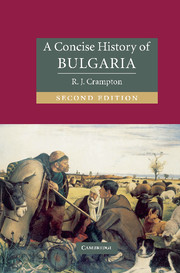Book contents
- Frontmatter
- Contents
- List of illustrations
- Preface
- Preface to the second edition
- Note on transliteration
- The Bulgarian lands: main rivers and mountains
- 1 THE BULGARIAN LANDS FROM PREHISTORY TO THE ARRIVAL OF THE BULGARIANS
- 2 MEDIAEVAL BULGARIA, 681–1393
- 3 OTTOMAN RULE IN THE BULGARIAN LANDS
- 4 THE NATIONAL REVIVAL AND THE LIBERATION
- 5 THE CONSOLIDATION OF THE BULGARIAN STATE, 1878–1896
- 6 FERDINAND'S PERSONAL RULE, 1896–1918
- 7 BULGARIA, 1918–1944
- 8 BULGARIA UNDER COMMUNIST RULE, 1944–1989
- 9 POST-COMMUNIST BULGARIA
- CONCLUSION
- Appendix 1 Bulgarian monarchs
- Appendix 2 Prime ministers of Bulgaria, 1879–2004
- Suggestions for further reading
- Index
- CAMBRIDGE CONCISE HISTORIES
3 - OTTOMAN RULE IN THE BULGARIAN LANDS
Published online by Cambridge University Press: 05 June 2012
- Frontmatter
- Contents
- List of illustrations
- Preface
- Preface to the second edition
- Note on transliteration
- The Bulgarian lands: main rivers and mountains
- 1 THE BULGARIAN LANDS FROM PREHISTORY TO THE ARRIVAL OF THE BULGARIANS
- 2 MEDIAEVAL BULGARIA, 681–1393
- 3 OTTOMAN RULE IN THE BULGARIAN LANDS
- 4 THE NATIONAL REVIVAL AND THE LIBERATION
- 5 THE CONSOLIDATION OF THE BULGARIAN STATE, 1878–1896
- 6 FERDINAND'S PERSONAL RULE, 1896–1918
- 7 BULGARIA, 1918–1944
- 8 BULGARIA UNDER COMMUNIST RULE, 1944–1989
- 9 POST-COMMUNIST BULGARIA
- CONCLUSION
- Appendix 1 Bulgarian monarchs
- Appendix 2 Prime ministers of Bulgaria, 1879–2004
- Suggestions for further reading
- Index
- CAMBRIDGE CONCISE HISTORIES
Summary
The vigorous but self-righteous Christians of the Victorian era created the impression that their co-religionists under Ottoman domination had suffered continual persecution for five hundred years. It was not so. Ottoman history is certainly not free from terrible incidents of hideous outrage, but in Europe these were occasional. Many, if not most, followed acts of rebellion and if this does not excuse the excess it perhaps goes some way to explain it. Other outbursts were spontaneous, localised and random, the result usually of a peculiar combination of personal, political, social or economic factors. It would be unwise to imagine the Ottoman empire as some form of lost, multi-cultural paradise, but on the other hand it would also be wrong to deny that at some periods in its history the empire assured for all its subjects, irrespective of religion, stability, security and a reasonable degree of prosperity.
OTTOMAN SOCIETY AND ADMINISTRATION
If the Christians of the empire at times enjoyed the blessings of peace and relative prosperity they were never given equality of status with Muslims. The Ottoman empire was a theocracy. Its head of state, the sultan, was also caliph, or the representative of God on earth and the supreme Muslim religious authority; he was pope as well as emperor. Non-Muslims were discriminated against in a variety of ways: they paid higher taxes than Muslims; Christian churches could not be as high as mosques; Christians could not wear the sacred colour green; no attempt could be made to proselytise amongst Muslims; at times, Christians had to dismount from their horses when a Muslim passed the other way; Christians could not carry arms; they could not become tanners because that was Mohammed's trade; and, most importantly, Muslim law was always superior to any other.
- Type
- Chapter
- Information
- A Concise History of Bulgaria , pp. 29 - 44Publisher: Cambridge University PressPrint publication year: 2005

